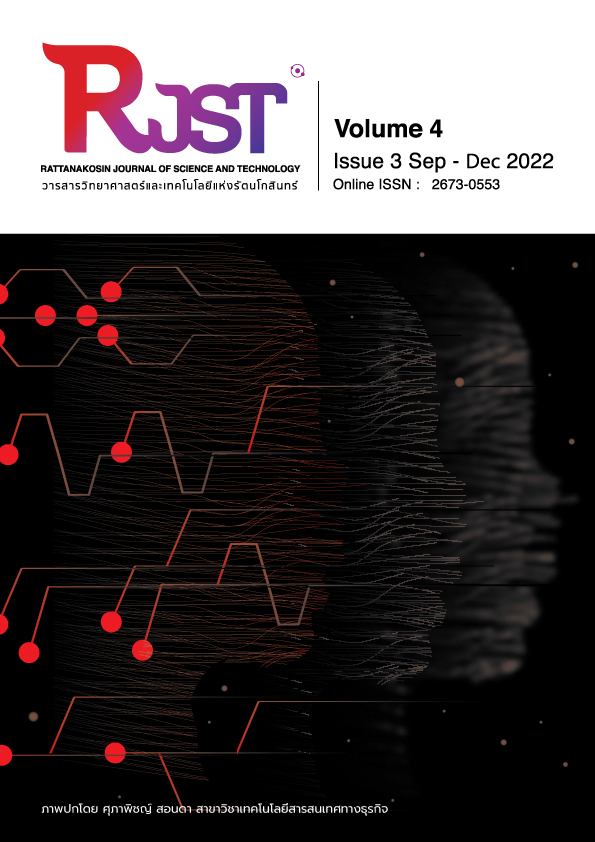Development of Thermal Insulators Made from Elephant Grass and Eggshell
Main Article Content
Abstract
The aim of this research was to study the effects of eggshell powder (ESP) addition on the insulation board performance prepared from elephant grass fiber (EGF) with 0, 10, 20, and 30 wt.% of ESP. The polymeric Methylene Diphenyl Diisocyanate (pMDI) contents were fixed at 10 wt.% as a binder. Hot pressing was employed to produce single-layered plain thermal insulation boards with a target density of 400 kg/m3. The sample panels were placed in a 450×450 mm2 mold with a thickness of 10 cm and pressed at temperatures of 120 °C for 5 min at a specific pressure of 147 bar. Density, moisture content, thickness swelling, water absorption, modulus of rupture, modulus of elasticity, fire spread rate, and thermal conductivity were investigated according to the standards of TIS 876-2547, JIS A 5905-2003, and ASTM C208-12. The results showed that the average density of the board was 414.6 kg/m3. The moisture content was 2.86–3.54%, which satisfied the TIS 876–2547. The thickness swelling and water absorption rate decreased as the ratio of eggshells increased. The replacement of eggshell content from 20 to 30% decreased water absorption, thickness swelling, and fire spread rate by 74–81%, 23–58%, and 41–50%, respectively, in comparison with 0% eggshell. Adding more than 20% eggshell powder replacement to elephant grass fiber caused a decrease in the modulus of rupture and modulus of elasticity of 30% and 24%, respectively, but met the requirements of the ASTM C208-12 standard. The thermal conductivity value of the board with 20% eggshell replacement was 0.062 W/m×K, which was in accordance with that of the glass wool board type 1 (0.063 W/m×K) according to the TIS 487-2526 standard.
Article Details

This work is licensed under a Creative Commons Attribution-NonCommercial-NoDerivatives 4.0 International License.
The content within the published articles, including images and tables, is copyrighted by Rajamangala University of Technology Rattanakosin. Any use of the article's content, text, ideas, images, or tables for commercial purposes in various formats requires permission from the journal's editorial board.
Rajamangala University of Technology Rattanakosin permits the use and dissemination of article files under the condition that proper attribution to the journal is provided and the content is not used for commercial purposes.
The opinions and views expressed in the articles are solely those of the respective authors and are not associated with Rajamangala University of Technology Rattanakosin or other faculty members in the university. The authors bear full responsibility for the content of their articles, including any errors, and are responsible for the content and editorial review. The editorial board is not responsible for the content or views expressed in the articles.
References
American Society for Testing and Materials. (2017). Standard Specification for Cellulosic Fiber Insulating Board, Standard C208-12. ASTM International: West Conshohocken, PA, USA.
Asdrubali, F., D’Alessandro, F., & Schiavoni, S. (2015). A review of unconventional sustainable building insulation materials. Sustainable Materials and Technologies. 4: 1–17.
Bekalo, S. A., & Reinhardt, H.-W. (2010). Fibers of coffee husk and hulls for the production of particleboard. Materials and Structures. 43(8): 1049–1060.
IEC 60695-11-10. (1999). Fire hazard testing—Part 11-10: Test flames—50 W horizontal and vertical flame test methods. https://www.iso.org/obp/ui#iso:std:iec:60695:-11-10:ed-1:v1:en (5 January 2022)
Keskin, H., Kucuktuvek, M., & Guru, M. (2015). The potential of poppy (Papaver somniferum Linnaeus) husk for manufacturing wood-based particleboards. Construction and Building Materials. 95: 224–231.
Luamkanchanaphan, T., Chotikaprakhan, S., & Jarusombuti, S. (2012). A Study of Physical, Mechanical and Thermal Properties for Thermal Insulation from Narrow-leaved Cattail Fibers. APCBEE Procedia. 1: 46–52.
Muthuraj, R., Lacoste, C., Lacroix, P., & Bergeret, A. (2019). Sustainable thermal insulation biocomposites from rice husk, wheat husk, wood fibers and textile waste fibers: Elaboration and performances evaluation. Industrial Crops and Products. 135: 238–245.
Paiva, A., Pereira, S., Sá, A., Cruz, D., Varum, H., & Pinto, J. (2012). A contribution to the thermal insulation performance characterization of corn cob particleboards. Energy and Buildings. 45: 274–279.
Pirayesh, H., Khanjanzadeh, H., & Salari, A. (2013). Effect of using walnut/almond shells on the physical, mechanical properties and formaldehyde emission of particleboard. Composites Part B: Engineering. 45: 858–863.
suriyapunpong, D. (2014). Isolation and characterization of celluiose from water hyacinth, sugar cane bagasse, and narrow leaf cattail [Srinakharinwirot University]. http://ir.swu.ac.th/jspui/handle/123456789/2631
Triwong, P. (2012). Application of Thermal Insulation Ceiling by Fiberboard. Journal of Industrial Technology. 8(1) : 79–84.
Tseghai, G. B., Berhe, B., & Wakjira, Y. (2019). Producing Fire Retardant Cotton Fabric Using Chicken Eggshell. 9: 1000396.
Vitrone, F., Ramos, D., Ferrando, F., and Salvadó, J. (2021). Binderless fiberboards for sustainable construction. Materials, production methods and applications. Journal of Building Engineering. 44: 102625.
Wechsler, A., Zaharia, M., Crosky, A., Jones, H., Ramírez, M., Ballerini, A., Nuñez, M., & Sahajwalla, V. (2013). Macadamia (Macadamia integrifolia) shell and castor (Rícinos communis) oil based sustainable particleboard: A comparison of its properties with conventional wood based particleboard. Materials and Design. 50: 117–123.
Yew, M. C., Ramli Sulong, N. H., Yew, M. K., Amalina, M. A., & Johan, M. R. (2015). Eggshells: A novel bio-filler for intumescent flame-retardant coatings. Progress in Organic Coatings. 81: 116–124.
Zhou, X., Zheng, F., Li, H., & Lu, C. (2010). An environment-friendly thermal insulation material from cotton stalk fibers. Energy and Buildings. 42(7): 1070–1074.


